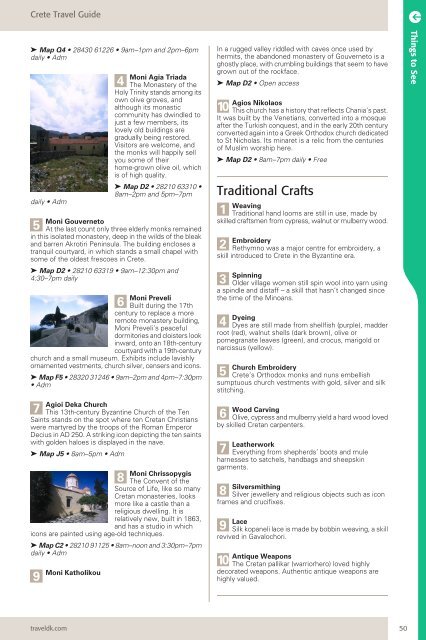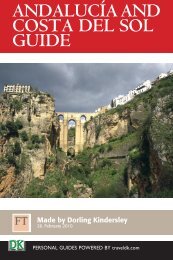CRETE TRAVEL GUIDE
CRETE TRAVEL GUIDE
CRETE TRAVEL GUIDE
Create successful ePaper yourself
Turn your PDF publications into a flip-book with our unique Google optimized e-Paper software.
Crete Travel Guide<br />
➤ Map Q4 • 28430 61226 • 9am–1pm and 2pm–6pm<br />
daily • Adm<br />
daily • Adm<br />
5<br />
4<br />
Moni Agia Triada<br />
The Monastery of the<br />
Holy Trinity stands among its<br />
own olive groves, and<br />
although its monastic<br />
community has dwindled to<br />
just a few members, its<br />
lovely old buildings are<br />
gradually being restored.<br />
Visitors are welcome, and<br />
the monks will happily sell<br />
you some of their<br />
home-grown olive oil, which<br />
is of high quality.<br />
➤ Map D2 • 28210 63310 •<br />
8am–2pm and 5pm–7pm<br />
Moni Gouverneto<br />
At the last count only three elderly monks remained<br />
in this isolated monastery, deep in the wilds of the bleak<br />
and barren Akrotiri Peninsula. The building encloses a<br />
tranquil courtyard, in which stands a small chapel with<br />
some of the oldest frescoes in Crete.<br />
➤ Map D2 • 28210 63319 • 9am–12:30pm and<br />
4:30–7pm daily<br />
Moni Preveli<br />
Built during the 17th<br />
century to replace a more<br />
remote monastery building,<br />
Moni Preveli’s peaceful<br />
dormitories and cloisters look<br />
inward, onto an 18th-century<br />
courtyard with a 19th-century<br />
church and a small museum. Exhibits include lavishly<br />
ornamented vestments, church silver, censers and icons.<br />
➤ Map F5 • 28320 31246 • 9am–2pm and 4pm–7:30pm<br />
• Adm<br />
7<br />
Agioi Deka Church<br />
This 13th-century Byzantine Church of the Ten<br />
Saints stands on the spot where ten Cretan Christians<br />
were martyred by the troops of the Roman Emperor<br />
Decius in AD 250. A striking icon depicting the ten saints<br />
with golden haloes is displayed in the nave.<br />
6<br />
➤ Map J5 • 8am–5pm • Adm<br />
Moni Chrissopygis<br />
The Convent of the<br />
Source of Life, like so many<br />
Cretan monasteries, looks<br />
more like a castle than a<br />
religious dwelling. It is<br />
relatively new, built in 1863,<br />
and has a studio in which<br />
icons are painted using age-old techniques.<br />
➤ Map C2 • 28210 91125 • 8am–noon and 3:30pm–7pm<br />
daily • Adm<br />
9<br />
Moni Katholikou<br />
traveldk.com<br />
8<br />
In a rugged valley riddled with caves once used by<br />
hermits, the abandoned monastery of Gouverneto is a<br />
ghostly place, with crumbling buildings that seem to have<br />
grown out of the rockface.<br />
➤ Map D2 • Open access<br />
10<br />
Agios Nikolaos<br />
This church has a history that reflects Chania’s past.<br />
It was built by the Venetians, converted into a mosque<br />
after the Turkish conquest, and in the early 20th century<br />
converted again into a Greek Orthodox church dedicated<br />
to St Nicholas. Its minaret is a relic from the centuries<br />
of Muslim worship here.<br />
➤ Map D2 • 8am–7pm daily • Free<br />
Traditional Crafts<br />
1 Weaving<br />
Traditional hand looms are still in use, made by<br />
skilled craftsmen from cypress, walnut or mulberry wood.<br />
2 Embroidery<br />
Rethymno was a major centre for embroidery, a<br />
skill introduced to Crete in the Byzantine era.<br />
3 Spinning<br />
Older village women still spin wool into yarn using<br />
a spindle and distaff – a skill that hasn’t changed since<br />
the time of the Minoans.<br />
4 Dyeing<br />
Dyes are still made from shellfish (purple), madder<br />
root (red), walnut shells (dark brown), olive or<br />
pomegranate leaves (green), and crocus, marigold or<br />
narcissus (yellow).<br />
5<br />
Church Embroidery<br />
Crete’s Orthodox monks and nuns embellish<br />
sumptuous church vestments with gold, silver and silk<br />
stitching.<br />
6<br />
Wood Carving<br />
Olive, cypress and mulberry yield a hard wood loved<br />
by skilled Cretan carpenters.<br />
7 Leatherwork<br />
Everything from shepherds’ boots and mule<br />
harnesses to satchels, handbags and sheepskin<br />
garments.<br />
8 Silversmithing<br />
Silver jewellery and religious objects such as icon<br />
frames and crucifixes.<br />
9 Lace<br />
Silk kopaneli lace is made by bobbin weaving, a skill<br />
revived in Gavalochori.<br />
10<br />
Antique Weapons<br />
The Cretan pallikar (warriorhero) loved highly<br />
decorated weapons. Authentic antique weapons are<br />
highly valued.<br />
50<br />
Things to See
















